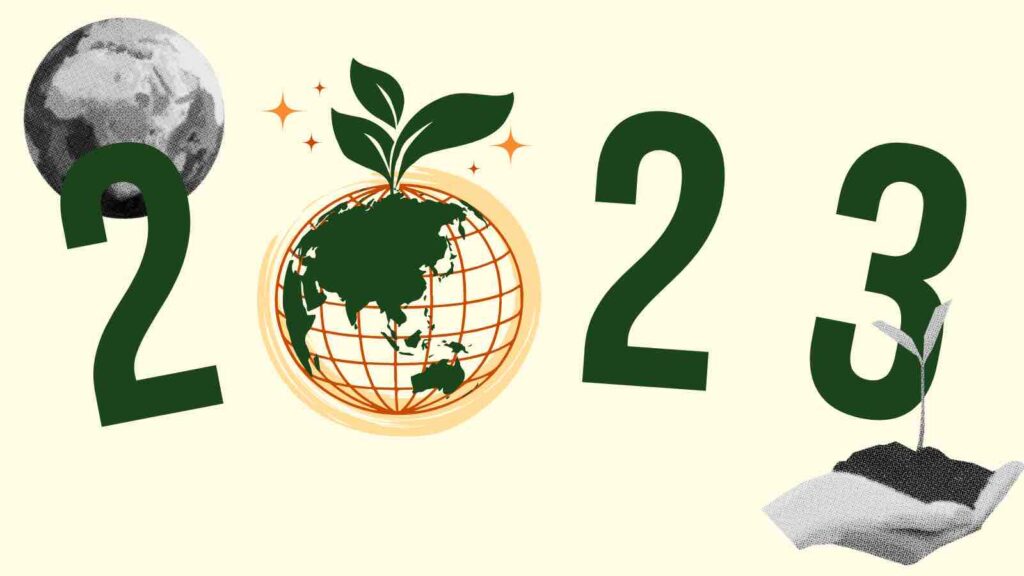The 2023 will be remembered as a year that stretched our collective vocabulary for describing the climate crisis and these climate terms are shaping climate action in Asia.
2023 is a year so anomalously warm, it paralleled conditions last seen 125,000 years ago, an era of mastodons and giant sloths. As Earth shattered temperature records, language strained to encapsulate the enormity of what we were witnessing.
RELEVANT SUSTAINABLE GOALS


The language of climate change evolved in 2023, mirroring the urgency and scale of the crisis. Terms like “heat dome” and “dystopian” vied for attention, reflecting a growing awareness of our changing environment. Our list of notable climate words for 2023 includes:
Net Zero
As long as greenhouse gas emissions exceed their removal, our planet will continue to warm. Achieving a balance is crucial to mitigate severe climate change effects.
The term “net zero” accommodates complex sectors like steel and meat production, known for significant emissions. Complete elimination of these emissions isn’t feasible yet, so alternative equilibrium strategies are essential. This includes enhancing nature’s role in carbon absorption – about one-third of carbon pollution is already mitigated by natural processes like forests, wetlands, and algae growth. Additionally, technological innovations offer mechanical carbon dioxide removal from the atmosphere.
At the 2015 Paris Climate Conference, the concept of “net zero” was widely adopted. The landmark Paris Agreement, signed by nearly 200 countries, aimed to balance emissions by the latter half of this century. This agreement marked the first comprehensive effort to address escalating emissions, setting 2050 as a target year for achieving emission equilibrium to avert the direst climate outcomes.
Carbon Removal
Revisiting the concept of balancing our climate equation, we have several methods to offset carbon emissions, including direct air capture. This process shouldn’t be confused with Carbon Capture and Storage (CCS). CCS primarily aims to prevent excess carbon dioxide from entering the atmosphere by capturing it at the source, such as industrial plants. On the other hand, direct air capture involves extracting carbon dioxide directly from the ambient air. This distinction is crucial; CCS might extend the operational life of fossil fuel plants, while direct air capture addresses unavoidable emissions.
Direct air capture, though promising, shouldn’t be seen as a panacea for climate change. Realistically implementing this technology on a scale sufficient to impact global warming presents considerable challenges. It would require deploying billions of machines over many years. Additionally, the captured carbon needs secure storage, which involves extensive permitting and infrastructure development. Scaling up this technology is not only costly but also requires substantial government investment and regulation.
There’s a concern among activists that an overreliance on costly and complex carbon removal technologies could detract from the more pressing goal of transitioning away from fossil fuels. The balance between innovative carbon removal and reducing reliance on fossil fuels remains a pivotal aspect of contemporary climate strategies.
Climate Finance
Climate finance is essential for efforts to mitigate and adapt to climate change and address the immediate impacts of the crisis. Meyer likens it to “layers of an onion,” with costs estimated in trillions. This includes transitioning from fossil fuels to clean energy, changing land use and agricultural practices, investing in resilient infrastructure and healthcare, and supporting vulnerable countries in the Global South that bear the brunt of climate change.
While investment in climate finance is growing, the pace is not keeping up with the urgent needs imposed by the rapidly changing climate. Steven Rothstein of Ceres notes, “For every $1 spent on fossil fuels, $1.7 is invested in renewable and emerging technologies.” While it’s significant that renewable investments are surpassing those in fossil fuels, the continued funding of new fossil fuel infrastructure remains a concern, considering the existing reserves of coal, oil, and gas.
Unpacking climate finance reveals various global, bilateral, and private financing mechanisms, all contributing to the large sums needed. Key initiatives include:
Green Climate Fund: An international goal exists to generate $100 billion annually through public and private investments. While the $100 billion target is still far off, smaller milestones are being reached. For example, the Green Climate Fund, aimed at helping developing nations transition to renewable energy, has started distributions, such as a $39 million project to restore Rwanda’s rainforests.
Carbon Markets: Carbon markets trade carbon offsets, allowing individuals, businesses, or countries to reduce their carbon footprint. For instance, a livestock farmer reducing methane emissions can offset this by funding wetland restoration. However, issues like double-counting and failing to reduce absolute emissions plague these markets. Opinions on carbon markets range from them being a flawed capitalist construct to an innovative solution to decarbonization challenges.
Loss and Damage (Climate Reparations): Climate change isn’t solely about reducing emissions or switching to clean energy and zero-emission technologies. With the world already heading towards 1.5 degrees Celsius of warming, adaptation to irreversible impacts is crucial. “Loss and damage,” sometimes termed reparations, acknowledges the disproportionate harm climate change inflicts on poorer communities least responsible for the crisis. Despite repeated affirmations by global leaders in UN texts, questions persist about who should contribute to funds aiding vulnerable nations, which countries qualify as particularly vulnerable, and whether affluent countries are obligated to contribute.
Scope 3 Emissions
Beyond the initiatives of national governments, the private sector plays a pivotal role in climate impact. Businesses’ contributions to climate change can be categorized into three scopes, which account for both direct and indirect emissions.
Scope 1 refers to direct emissions from a company’s operations. For example, in a car manufacturing company, this would include the emissions from fossil fuels burned for activities such as gas heating, deliveries, or operating machinery. These are emissions over which the company has direct control.
Scope 2 addresses indirect emissions that are a consequence of the company’s operations but occur at another location. A typical example is the emissions generated at a power plant providing electricity to a business. While these emissions are a result of the company’s energy consumption, they occur elsewhere.
Scope 3 is the most comprehensive and elusive category, encompassing all other indirect emissions linked to a company’s activities. This includes emissions from product use, third-party deliveries, and waste disposal. It’s a broad category that often represents the largest portion of a company’s carbon footprint.
While significant progress has been made in reporting Scope 1 and Scope 2 emissions, with over 80% of S&P 500 companies disclosing some form of climate data, Scope 3 emissions remain a challenge. These emissions can exceed a company’s direct emissions by more than 11 times, yet they are often not fully accounted for due to their complexity and the extensive chain of activities involved. The regulation and management of Scope 3 emissions continue to be contentious, as they represent a significant portion of a company’s environmental impact.
AQI (Air Quality Index)
The Air Quality Index (AQI), a vital color-coded tool measuring air safety, has shifted from a niche interest to a daily necessity for many. Previously, only those keenly interested in air quality closely followed the AQI. However, the past decade’s smoke-filled summers in the West have made checking the AQI a routine part of people’s morning rituals.
In 2023, this trend took a dramatic turn. Wildfires raging in Canada propelled hazardous air into parts of the United States previously unacquainted with such severe air pollution, bringing the AQI into broader public discourse. This surge in air pollution led to a spike in Google searches for AQI, particularly along the East Coast and in the Midwest, as residents grappled with this newfound environmental threat.
The health implications of inhaling fine particles from wildfire smoke cannot be understated, with established links to serious long-term effects like heart attacks, lung cancer, and dementia. This concern was brought into sharp focus when New York City faced criticism for its delayed response in alerting the public and distributing N95 masks. In parts of Brooklyn, AQI levels skyrocketed to 484, a figure alarmingly beyond the scale’s maximum limit. Readings over 300, marked as maroon on the AQI chart, are classified as “hazardous” air quality, posing a risk even to those in good health. This situation underscores the growing urgency for increased air quality awareness and proactive public health measures in an era marked by escalating climate challenges.
You may also be interested in :
10 Circular Economy Trends To Look Out For In 2024, Reshaping Production and Consumption



